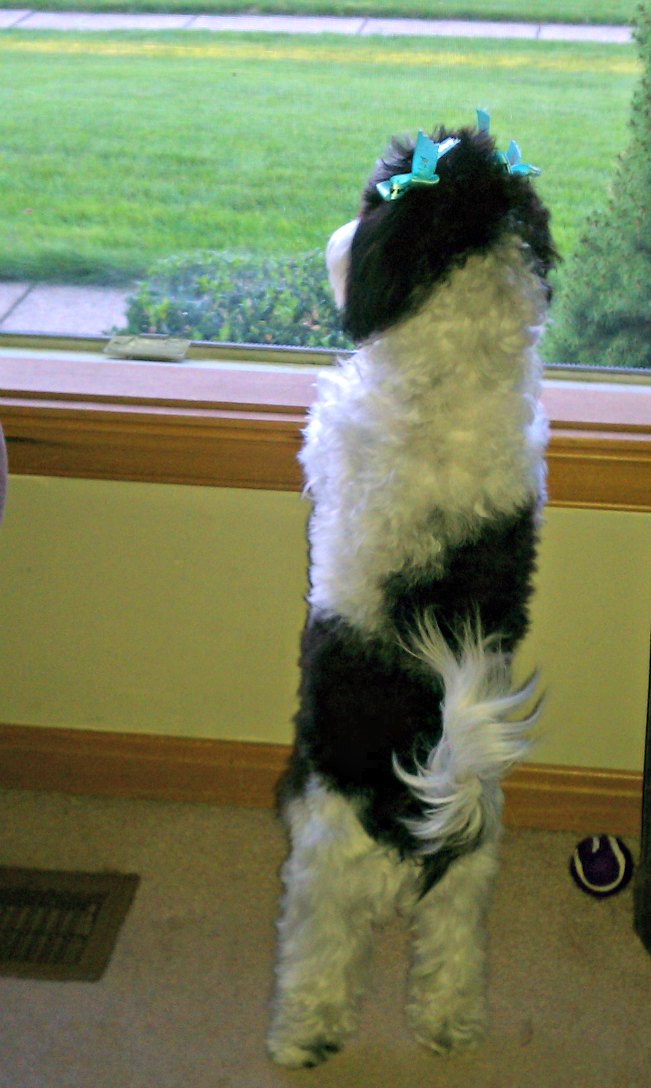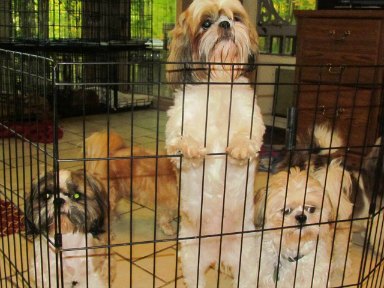Separation Anxiety in Dogs
Even the addition of another pet may not cure Separation Anxiety in Dogs
By Janice Jones |Last Updated 02-13-2020
Separation anxiety in dogs is one of the most common psychological problems that dogs develop and it is very common in small/toy breeds. It’s an anxiety disorder, and can be defined as a state of intense panic brought on by the dog’s isolation/separation from her owner. Most dogs will exhibit problem behaviors shortly after their owners leave, often within the firs 20-40 minutes.
Dogs are social animals and are accustomed to being a part of a pack. In the wild, wolves remain in close family units. Domesticated dogs consider their humans to be their pack and they thrive on the social interactions that they receive from their favorite human. No dog likes to be left alone for long periods of time, but some dogs react more intensely than others and these are the ones most prone to separation anxiety.
What causes Separation Anxiety in Dogs?
Experts do not completely understand why some dogs suffer from separation anxiety and, under similar circumstances, others don't.
What we do know is that it is an anxiety or panic disorder and any damage that the dog may do while the owner is away is not malicious. Dogs do not destroy property or mess in the house in order to punish their owners or seek revenge.
There seems to be several probable causes of separation anxiety. Most seem to be environment, but a genetic component may also present.
Separation Anxiety in Dogs Adopted from Shelters
One group of dogs that have a separation anxiety disorder is dogs adopted from shelters. Most of these ‘shelter dogs’ have undergone substantial trauma in their lives.
They were abandoned by their previous owners, and as the new owner, you don’t always have the full (true) story on why they were relinquished.
Some have been abused either physically or psychologically or simply suffered under the hands of inexperienced owners who did not know how to handle their individual needs.
Separation Anxiety in Dogs Purchased from a Pet Store
Another group of dogs that seem to be prone to separation anxiety are those purchased as puppies from pet stores.
Dogs that were separated from their mothers and siblings too early have been identified as being especially prone to separation anxiety also. This group of dogs often includes puppies from pet-stores.
To be able to arrive at the store ready to be sold at 8 weeks of age, they are usually taken from their mothers well before the earliest possible age, transported from their original home to the store and then confined to a small glass box or a cage in the pet store for anywhere between a few weeks to a few months until they are sold.
Early weaning from the mother and lack of early socialization that a puppy would normally receive from a breeder and his canine mother causes stress and leads to anxiety. The lack of adequate exercise in these puppies tends to only exacerbate the problems.
Separation Anxiety in Dogs:
Perceived Threats in Otherwise Healthy Dogs
Even if you purchased your dog from the perfect breeder, the lack of human interaction that occurs when the owner must work long hours can bring on separation anxiety.
Sadly, neglect is the number-one cause of separation anxiety in dogs. Dogs need affection and human company to be happy and content. Neglect is a strong term and most owners would never consider themselves guilty of neglecting their dog.
But, It can happen to the best of us.
We suddenly take a job outside the home and now we have dog who is being left alone when they have had little experience spending an entire day without us.
Or, we take our little dog on vacation with us and spend every waking hour in her company.
Now the vacation is over, we go back to work, and our little dog is left alone. Conversely, we go on vacation and leave our little dog in a boarding kennel. She perceives our absence in a very negative way and reacts in panic mode when we return to work.
Even minor changes in household routines such as the birth of a child, the addition of a new pet, or a child leaving for college can upset the routine of some dogs. None of these normal events should cause a dog to react badly, but we still don’t fully understand what goes through their little heads.
Symptoms of Separation Anxiety in Dogs
The symptoms seen in dogs with separation anxiety are pretty unique. If your dog shows signs of any of these behaviors while you are away, he may have separation anxiety.
- Digging, chewing or scratching at doors
- Barking, Yelping, Howling and crying
- Urinating or defecating in the house even when they are house broken
- Destructive chewing of furniture or other household items
Separation Anxiety in Dogs: A typical Scenario
Consider the following scenario:
First, your dog begins to understand when you’re about to leave because they have learned to pick up the cues you give off putting on your coat or gathering your keys.
They begin to feel anxious. They may follow you from room to room, whining, trembling, and crying. Some dogs even become aggressive, in an attempt to stop their owners from leaving.
When you have left, the anxious behavior will rapidly get worse and usually peaks within half an hour. They may bark nonstop, scratch and dig at windows and doors in their mistaken belief that they can get out and be with you.
They might also chew inappropriate items, and even urinate and defecate inside the house. In extreme cases, they might harm themselves by licking or chewing their skin until it is raw or pulling out their fur.
Some dogs will also engage in
obsessive-compulsive behaviors, like spinning and tail-chasing.
Upon your return, they will be excessively excited, and will leap around
you in
a state of delight for a long period of time, much more than the usual
30
seconds to one minute that is common in happy, well-adjusted dogs.
Some owners misunderstand this extended greeting. These owners do not understand that such a greeting actually signifies the presence of a psychological disorder (i.e.separation anxiety disorder). Instead, these pet owners actually encourage their dog to get more and more worked up upon their return by fueling the dog’s excitement, encouraging them to leap around.
What the owner is doing is endorsing the dog’s belief that the owner’s return is the pinnacle point of the day and your subsequent departure the next day is the worst part of the day. This reinforces the behavior making the next and subsequent days harder and harder.
How to Make a Diagnosis
We might not be dog psychologists, but it is often easy for us to pinpoint whether our dog’s symptoms are a result of a separation anxiety.
Consider what is happening and determine if the inappropriate behavior happens almost exclusively when you are away from home or when the dog is left alone for periods of time. While doing this, you must also rule out other possible problems.
For example, if your dog is urinating in the house while you’re away but not showing any other symptoms, he might be suffering from a urinary tract infection that can be easily treated with medication. If a dog is having accidents in the house after being left alone for 10 hours or more, the problem is not with the dog but the owner.
People cannot go that long without needing to visit a restroom, so it’s hard to expect a dog with a much smaller bladder to do what humans cannot.
Questions to Ask Yourself when Diagnosing
Separation Anxiety in Dogs
- Does your dog like to follow you from room to room and begin to panic if he gets trapped in a room and cannot reach you?
- Does he spend too much time in elaborate greeting rituals upon your return?
- Does he refuse to be left alone in a room or outdoors without you?
- Does his symptoms seem to occur only when you are away?
If the answer is yes to some or most of these questions, then you, the dog psychologist has diagnosed your dog with separation anxiety!
Ideas to Treat Separation Anxiety in Dogs
It is often hard to determine how severe the anxiety is in your dog, so it’s best to try some of these techniques first and see which ones make any difference.
Arrival Rituals
Work on arrival and departure routines
and remain calm and unemotional. For example, when you arrive home, ignore your
dog for the first few minutes, then speak to him in a quiet voice and calmly
pet him. This low-keyed approach to greetings will go along way towards reducing the separation anxiety in dogs.
A scent of You
Sometimes an article of clothing that you recently wore will help keep him calm if placed in his favorite bed. I have also tried spraying my dog’s area with lavender as a calming technique or adding a lavender candle or room scent while I’m out. A lit candle is not a good idea, but scented candles placed on a warming plate often do just as good.
Departure Cues
Train your dog by using a word or action that you and everyone in your home will use each time you leave.
This is similar to teaching basic commands such as sit, stay, leave it or wait. I personally use the words, “I’ll be back.” And snap my fingers. I do this every time I leave the house without the dogs such as when I go to get the mail or empty the trash.
Since most of my dogs stay on the first floor of my home, I will repeat this ritual when I go upstairs.
Music as a Departure Cue
Another option might be to turn on a radio or TV. Music may work for some dogs, but not all, but if you pair the music with your cue that it’s time to leave, many dogs will associate the music with your leaving.
This only works if you use it as part of your departure routine. Unfortunately, this has not worked for me because many family members in my household will play music whether or not they are home.
Help for Destructive Chewing
If chewing is part of his panic attack, make sure he has plenty of interesting chew toys, bones and a hard treat or two. If you use dental chews, this might be a good time to present him with his daily treat right before you leave. Make that part of your departure routine.
Ever wonder why there are so many ‘puzzle’ type toys on the market today? There is no denying that they are making their manufacturers and all the middlemen plenty of income, but the reason they are so popular is because they distract dogs for longer periods of time and help calm separation anxiety in dogs.
Puzzle toys that you can stuff with special treats or even a portion of their daily diet often work well if the only time they receive these special items is when you leave.
Provide A Room with a View to help ease
Separation Anxiety in Dogs

If at all possible, provide a place where she can remain until you return complete with her favorite bed, water bowl and a view.
A room with a view gives her the option of distraction as she watches the world go by why she waits for your return. This does not work if she decides to chew, scratch or try and tear her way through the window. Sometimes being able to look out means that she will bark at everything in her range of sight which is not an ideal situation especially if you live in an apartment.
Crating an anxious dog often causes more problems than it solves. A dog with separation anxiety who must remain in a crate all day will become even more anxious, urinating, defecating and trying to bite herself to freedom.
The crate then becomes useless as a safe place. Dogs that enjoy crates should be allowed to have access to them while you are away, but keep the door open so they can enter and leave at their will.
A better way to assure your dog will have some freedom, but so much as to destroy your home would be to use infant gates and confine the dog to a small area where all the doggie necessities are within easy reach – soft comfy bed, water bowl, toys, chews, treats, crate if used, and a window to observe the world.
Exercise
Provide time in the morning for a brisk walk. This is essential for large dogs and very active small breed dogs. Even those “couch potato breeds” will benefit from short 15 minute early morning walk and you will too. If your dog is tired, she is more likely to rest or sleep part of the day while you are away.
Other Options
- Doggie Day Care
- Dog walkers that visit while you’re at work
- Over the counter calming products such as Comfort Zone (DAP) plug-ins and sprays, Thunder Shirt, Pheromone Releasing Collars
What Doesn't Work...
Any type of punishment is counterproductive to treating separation anxiety in dogs. Think how it would be as a human suffering from an anxiety disorder. The last thing you would want to help relieve your symptoms would be for someone to punish you. Punishment does not work and may increase the anxiety symptoms.
You might think that getting another pet will solve the problem and in some dogs it might help. Most dogs, however, will not see the second dog as an equal substitute for your presence. There is no guarantee that the presence of a new dog will ease the anxiety.
Acting overly sympathetic when you hear the dog cry just tends to affirm to the dog that her distress is real and there must be a legitimate reason for her to act in inappropriate ways. We will soothe a crying baby and mistakenly believe that is what we should do with a dog. This action on our part only tends to validate her feelings
Separation anxiety is not one of those 24 hour bugs that go away quickly. It does require you to be diligent, consistent and methodical in your approaches. If nothing seems to work, additional actions can be taken to desensitize the dog to her anxiety. Often this process is lengthy and easier to accomplish with the help of a dog behavioral specialist.
"Hi, I'm Janice Jones, a former veterinary technician and Shih Tzu expert with over 40 years of experience with the breed. Through Miracle Shih Tzu, I combine my medical background and extensive breed knowledge to provide reliable, practical advice for Shih Tzu owners. My mission is to help you give your Shih Tzu the happiest, healthiest life possible through evidence-based information and real-world solutions. Whether you're new to the breed or a seasoned owner, you'll find trusted guidance here for all aspects of Shih Tzu care.
I hold an undergraduate degree in Psychology with a minor in biology, Early Childhood Education, and Nursing, and a Master's in Mental Health Counseling.




